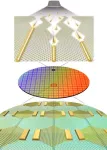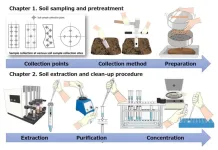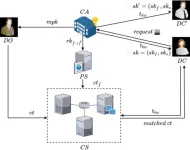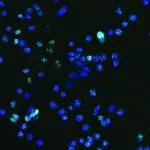(Press-News.org) Lead author Neta Rosenzweig, PhD, of the Ann Romney Center for Neurological Diseases, and senior author Oleg Butovsky, PhD, of the Ann Romney Center and Gene Lay Institute of Immunology and Inflammation, share key messages from their paper “Sex-Dependent APOE4 Neutrophil-Microglia Interactions Drive Cognitive Impairment in Alzheimer’s Disease” published in Nature Medicine.
How would you summarize your study for a lay audience?
In this manuscript, we identify that a major genetic risk factor for the late onset of Alzheimer’s disease, APOE4, impairs the communication of immune cell neutrophils with immune cells of the brain microglia. This miscommunication leads to cognitive impairment in female Alzheimer’s patients. One of the mechanisms identified was related to the induced expression of an immune molecule called IL17F in neutrophils, which causes microglia not to respond to neurodegeneration. Our findings from blocking this molecule in preclinical models of Alzheimer’s disease suggests a potential translational basis for unmet clinical needs.
What question were you investigating?
We asked how sex, APOE4, and cognitive status interact in regulating neutrophil phenotype and functions that impair microglial response to neurodegeneration.
We also asked whether APOE4 regulates neutrophils in a cell-autonomous manner and whether deleting APOE4 in neutrophils could affect microglial phenotype and AD pathology in mouse models.
What methods or approach did you use?
In collaboration with Reisa Sperling, MD, and Hyun-Sik Yang, MD, both of the Brigham’s Department of Neurology , we isolated blood neutrophils from healthy controls (HC) and Alzheimer’s disease (AD) donors expressing different APOE variants. In addition, in collaboration with Bart Eggen, PhD, of the University of Groningen, the Netherlands, we isolated microglia from the brains of HC and AD donors carrying different APOE variants as a guide to our original hypothesis, which was validated in humanized mouse models of AD. Leveraging single-cell transcriptomics across APOE variants in both sexes, multiplex flow cytometry, and validation in two independent cohorts of APOE4 female AD patients, we identified a new subset of neutrophils interacting with microglia associated with cognitive impairment. We also used a humanized mouse model of AD designed to delete APOE variants only in neutrophils to validate our findings in human samples mechanistically.
What did you find?
We identified a new subset of neutrophils interacting with microglia associated with cognitive impairment. This phenotype is defined by increased IL-17 and IL-1 co-expressed gene modules in blood neutrophils and in microglia of cognitively impaired female APOE4 carriers, showing increased infiltration to the AD brain. APOE4 female IL-17+ neutrophils upregulated the immunosuppressive cytokines IL-10 and TGFb and immune checkpoints associated with accelerated immune aging, including LAG-3 and PD-1. Deletion of APOE4 in neutrophils reduced this immunosuppressive phenotype and restored the microglial response to neurodegeneration (MGnD), limiting plaque pathology in AD mice. Mechanistically, IL-17F upregulated in APOE4 neutrophils interacts with microglial IL-17RA to suppress the induction of MGnD phenotype, and blocking this axis supported cognitive improvement in AD mice.
What are the implications?
Our data indicate that targeting IL-17F may benefit APOE4 female carriers, who are less responsive to current anti-amyloid-beta therapeutics and develop amyloid-related imaging abnormalities as a common side effect of treatment with amyloid-lowering monoclonal antibodies. This may result in precise therapeutic interventions for AD according to sex and APOE4 genotype, providing an alternative strategy for an unmet clinical need.
What are the next steps?
The next steps include translating these findings into a potential therapeutic intervention for AD and continuing to investigate the immune landscape associated with cognitive impairment in patients to identify additional molecular targets.
Authorship: In addition to Rosenzweig, Butovsky, Sperling and Yang, Mass General Brigham authors include Kilian L. Kleemann, Madison Carpenter, Madeline Grucci, Michael Aronchik, Isabel Valenbreder, Joya Cooper-Hohn, Malvika Iyer, Rajesh K. Krishnan, Kisha N. Sivanathan, Wesley Brandão, Taha Yahya, Ana Durao, Zhuoran Yin, Michael J. Properzi, Roni Nowarski, Howard L. Weiner, In addition to Eggen, other authors include Thomas Rust, Nieske Brouwer, Jean Paul Chadarevian, Hayk Davtyan, and Mathew Blurton-Jones.
Funding: This study was supported by the Cure Alzheimer’s Fund; BrightFocus Foundation 2020A016806; National Institute of Aging (R01AG051812, R01AG054672, R01AG075509, R21AG076982,R01AG080992, K23AG062750, P30 AG066519, U19 AG06970101, P01AG026694); National Eye Institute (R01EY027921), National Institute of Neurological Disorders and Stroke (R01NS088137, R21NS104609, R21NS101673) National Institute of General Medical Sciences (R01GM132668), Nancy Davis Foundation innovative Award. Alzheimer’s association research fellowship (AARF-21-846786) National Multiple Sclerosis Society (FG-2108-38372), and Department of Defense (MS210257).
Disclosures: Butovsky, Rosenzweig, and Kleeman are inventors of a patent licensed by Brigham and Women’s Hospital for the use of IL17F inhibitors for the treatment of neurodegenerative diseases. Butovksy has a collaboration with GSK and Regulus Therapeutics. Research funding from Sanofi, GSK, honoraria for lectures, consultancy: UCB, Camp4, Ono Pharma USA, General Biophysics.
END
A new artificial intelligence (AI) tool that can help to select the most suitable treatment for cancer patients has been developed by researchers at The Australian National University (ANU).
DeepPT, developed in collaboration with scientists at the National Cancer Institute in America and pharmaceutical company Pangea Biomed, works by predicting a patient’s messenger RNA (mRNA) profile. This mRNA - essential for protein production - is also the key molecular information for personalised cancer medicine.
According to lead author Dr Danh-Tai Hoang from ANU, when combined with a second tool called ENLIGHT, DeepPT ...
A research team led by Director JO Moon-Ho of the Center for Van der Waals Quantum Solids within the Institute for Basic Science (IBS) has implemented a novel method to achieve epitaxial growth of 1D metallic materials with a width of less than 1 nm. The group applied this process to develop a new structure for 2D semiconductor logic circuits. Notably, they used the 1D metals as a gate electrode of the ultra-miniaturized transistor.
Integrated devices based on two-dimensional (2D) semiconductors, which exhibit excellent properties even at the ultimate limit of material thickness down to the atomic ...
A final year computer science undergraduate from the University of Bath has been named amongst the UK’s best student game developers, having won an award in the “Games with purpose” category at the Games Innovation Challenge 2024.
Salmaan Zhang competed against university and college students from across the country to win one of seven categories in the competition, which is sponsored by UNiDAYS and delivered by NSE (National Student Esports).
The challenge asked students in the UK to create the most innovative game in just eight weeks. Submitted entries were shortlisted and then judged by industry experts in several ...
Concern about the effects of PFAS are of increasing globally. Also there is no accurate method for analyzing multiple PFAS in soil. Hence, a team of PFAS researchers led by NARO et.al sought to develop a stable and accurate method for analyzing multicomponent PFAS in the soil (Ministry of Agriculture, Forestry and Fisheries -MAFF project).
Unlike the PFAS analysis method for water samples, it is difficult to ensure the extraction efficiency of the target PFAS in diverse soil samples. In Japan, there are 381 soil types, with volcanic ash soils being the predominant. Since these soils possess high carbon content, ...
Many cat owners are familiar with torn cushions, carpets, and couches. The feline instinct to scratch is innate but is often perceived as a behavioral problem by cat owners and sometimes leads to interventions that are not cat friendly.
Now, an international team of researchers has investigated which factors influence undesired scratching behavior in domestic cats. They published their findings in Frontiers in Veterinary Science.
“Here we show that certain factors – such as the presence of children at home, personality traits of cats, and their activity levels – significantly impact the ...
The security of traditional attribute-based searchable encryption schemes relies on traditional number-theoretic assumptions, and thus they are not able to resist the threat of quantum algorithms. Meanwhile, existing lattice-based searchable encryption schemes have two main problems: one is the low efficiency of the execution of encryption, key generation and search algorithms. The second is the large space required for storing search trapdoors.
To solve the problems, a research team led by Yang YANG published their new ...
The hot-end components of high-performance high-speed aircrafts need to meet performance requirements such as long service life, wide temperature range oxidation resistance and ablation resistance. This puts forward higher requirements for high-temperature service performance of thermal protection system (TPS).
With low density, low expansion and excellent high temperature mechanical properties, carbon-carbon (C/C) composites are expected to be the best choice for the new generation of TPS. However, the oxidation sensitivity of C/C composites severely limits their service life in high-temperature ablation environment. It ...
Behavioral interventions are strategies designed to help people change their behaviors in a way that is positive for themselves and the community. These behaviors can relate to various topics, such as health, citizenship, ecology, and more. Interventions can be applied individually, like someone seeing a psychologist to quit smoking, or collectively, such as NGOs and public institutions investing in anti-smoking campaigns or raising awareness about the dangers of drunk driving.
Understanding how to adapt behavioral interventions to different cultures is essential for the success of health ...
New class of cancer mutations discovered in so-called ‘junk’ DNA
Using artificial intelligence, Garvan Institute researchers have found potential cancer drivers hidden in so-called ‘junk’ regions of DNA, opening up possibilities for a new approach to diagnosis and treatment.
Non-coding DNA – the 98% of our genome that doesn’t contain instructions for making proteins – could hold the key to a new approach for diagnosing and treating cancers, according to a new study from the Garvan Institute of Medical Research. The findings, ...
Ever wondered why you performed worse than expected in that final university exam that you sat in a cavernous gymnasium or massive hall, despite countless hours, days and weeks of study? Now you have a genuine reason – high ceilings.
New research from the University of South Australia and Deakin University has revealed a link between rooms with high ceilings and poorer examination results.
A study published in the Journal of Environmental Psychology, led by architecture and psychology-trained UniSA researcher Dr Isabella Bower in collaboration with educational psychology researcher Associate Professor Jaclyn Broadbent from Deakin University, demonstrates that building design impacts ...






